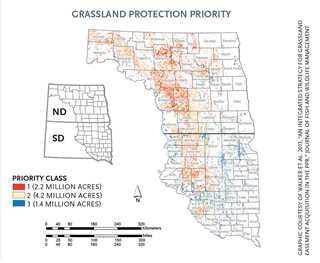Understanding Waterfowl: A Matter of Productivity
A closer look at why the Prairie Pothole Region is North America's most productive waterfowl breeding area
A closer look at why the Prairie Pothole Region is North America's most productive waterfowl breeding area
By Kaylan Kemink and Tanner Gue
In many years, more than half of North America's ducks breed in the Prairie Pothole Region of the United States and Canada, a landscape once described as a sea of grass interspersed with millions of small "pothole" wetlands. Biologists have known for decades that native prairie with a high wetland density is the gold standard for producing ducks. Large expanses of unbroken grassland offer secure upland cover for ground-nesting hens, and numerous small, shallow wetlands provide the invertebrate food resources female ducks need to produce eggs and successfully raise their broods. While both grass and water are important to breeding waterfowl, wetlands often prove to be the most unpredictable resources on the landscape.
The variability of wetland conditions on the prairies is largely influenced by regional climate patterns. Prairie potholes depend on annual precipitation, primarily in the form of winter snowfall and spring rains, to fill them with water. During times of drought, there are fewer wetlands on the landscape and therefore fewer places where duck pairs can settle and establish breeding territories. Despite these impacts, drought is a natural part of the ecosystem and is essential to maintaining the productivity of prairie wetlands. Drought allows wetland soils to consolidate, emergent vegetation to become reestablished, and nutrients that were stored in dead plant material to be released. When wet weather returns and these dry wetland basins are once again filled with water, invertebrate populations explode and breeding pairs and broods find an abundance of food and cover in recently flooded habitats.

Although we will never be able to control Mother Nature, we can "keep the table set" for ducks during times of drought by conserving the most productive waterfowl breeding habitats on the prairies. Ducks Unlimited's methods have grown more sophisticated over the years, but our objective has remained the same since the organization's inception in 1937-to conserve wetlands and associated upland habitats on landscapes that will provide the biggest "bang for the buck" for breeding waterfowl. Today, DU's prairie conservation work is guided by a science-based planning process (see map). Once tracts of land are selected for conservation, DU works with landowners to determine the habitat management practices and programs that are the best fit for their property and interests. Among DU's most effective conservation tools are wetland and grassland easements. These voluntary agreements with farmers and ranchers perpetually protect key waterfowl habitats while allowing landowners to continue to use their property for agriculture and recreation. Under special circumstances, DU purchases tracts of land that are of particularly high value to breeding waterfowl. After restoring and protecting key habitats with perpetual conservation easements, DU sells or donates the property to a government agency or other conservation buyer. Proceeds from the sale are returned to DU's revolving land fund to be used to protect more waterfowl habitat.
Thanks to the support of DU volunteers, members, and many other partners and programs, we have made great progress in conserving crucial waterfowl breeding habitats on the prairies. For example, since forming a partnership in 1998, DU and the U.S. Fish and Wildlife Service have permanently protected almost 1.1 million acres of grasslands and more than 220,000 acres of wetlands with conservation easements in the U.S. portion of the Prairie Pothole Region. Moving forward, DU will continue to apply the latest wetlands and waterfowl research to deliver its habitat conservation programs on the prairies as efficiently and effectively as possible. That is, after all, the best way to ensure that when waterfowl return to pothole country, the birds will have the habitat and resources they need to successfully nest and raise their broods.
The Importance of Migration and Wintering Habitats Although studies have shown that events occurring on the breeding grounds have the largest impact on annual waterfowl populations, migration and wintering habitats also play a vital role in sustaining the birds throughout their annual cycle. Food energy acquired during the winter months allows waterfowl to survive bitter-cold weather and prepare for their long, energetically taxing migration back to their breeding grounds in spring. On their journey north, waterfowl stop to rest and refuel at key staging areas along the flyways. When food resources such as invertebrates and seeds produced by native moist-soil plants are abundant in stopover wetlands, ducks tend to arrive on the breeding grounds in better physical condition. This is important because female ducks that arrive on the breeding grounds with more fat reserves nest earlier, lay larger clutches of eggs, and are more likely to renest if their first nests fail. In addition, earlier nesters are usually more successful at fledging broods than later-nesting hens. For these reasons, Ducks Unlimited works to conserve crucial waterfowl habitats not only on the breeding grounds, but also on key migration and wintering areas such as the Central Valley of California, Mississippi Alluvial Valley, Gulf Coast, mid-Atlantic coast, and Nebraska's Rainwater Basin. To ensure healthy populations of waterfowl, we must conserve all the habitats required to keep the birds healthy year-round.
Ducks Unlimited uses cookies to enhance your browsing experience, optimize site functionality, analyze traffic, and deliver personalized advertising through third parties. By continuing to use this site, you agree to our use of cookies. View Privacy Policy